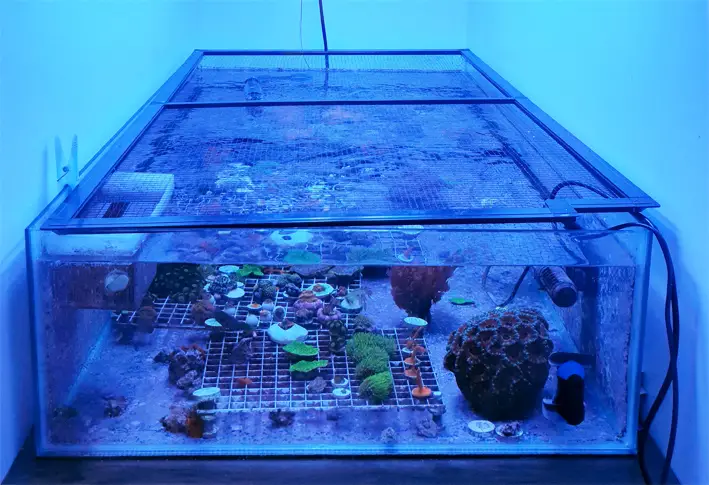What Is a Frag Tank?

A frag tank is a specialized aquarium used for propagating coral fragments, also known as “frags.” It is a smaller tank that is set up specifically for the purpose of growing coral fragments into larger colonies.
A frag tank usually is designed to be compact and space-efficient and are typically shorter than standard tanks. The tank is typically filled with water from a mature reef tank, and the coral fragments are placed on a solid surface such as a rock or a plug. Sometimes they are placed on plastic grids that allows the coral fragments to attach to the surface and begin to grow.
Frag tanks are typically equipped with specialized lighting that provides the proper spectrum and intensity for coral growth. They also have proper water flow and circulation to provide a healthy environment for the coral fragments.
The main advantage of using a frag tank is that it allows hobbyists to propagate their own coral colonies and expand their reef tank without having to purchase new coral. It also allows hobbyists to share coral with other hobbyists and help to conserve wild coral populations.
A frag tank is a great way to get into coral propagation and it is also a good opportunity to learn more about coral and the way they grow. It’s important to keep in mind that maintaining a frag tank requires knowledge of coral and their specific needs, and to follow the proper protocols for coral propagation to ensure the coral’s survival and growth.
How To Set Up a Frag Tank?
Setting up a frag tank is a mostly simple process, but it does require some specialized equipment and knowledge of coral care. Here is a basic overview of the steps involved in setting up a frag tank:
- Choose the right tank: Select a tank that is made of acrylic or glass.
- Select a location: Choose a location for the tank that has good lighting and is easy to access for maintenance. Avoid placing in direct sunlight or in a drafty location. Typically frag tanks are kept in back rooms, or the basement as they are less attractive to look at.
- Add substrate: Add a layer of substrate to the bottom of the tank, such as live sand or crushed coral. This will provide a base for the coral fragments to attach to and grow. Some folks like to use suction cup racks to support their coral, or plastic grid systems.
- Add live rock: Add live rock or artificial rock structures to the tank. This will provide a natural-looking environment and a place for beneficial bacteria to thrive.
- Install lighting: Install specialized lighting that provides the proper spectrum and intensity for coral growth. LED lights or metal halide lights are commonly used.
- Install water flow and circulation: Install a sump system and which ever pumps are needed to provide proper water flow and circulation throughout the tank. This will largely depend on the type of coral that is in the tank.
- Add water: Fill the tank with water from a mature reef tank. This will provide beneficial bacteria and nutrients for the coral fragments.
- Add coral fragments: Add the coral fragments to the tank and place them on the substrate or live rock. Make sure to keep the coral fragments in the same lighting and water flow conditions as their original tank.
- Monitor water chemistry: Keep an eye on water parameters like pH, temperature, salinity, Nitrates and Phosphates.
- Observe and maintain: Observe the coral fragments regularly and take action if necessary. Coral fragments require regular maintenance, such as cleaning and pruning, to promote growth.
Conclusion
It’s important to note that coral fragments require specific care and conditions to thrive, so it’s crucial to do proper research on the coral species you want to propagate and to follow the proper protocols for coral propagation. It’s also important to make sure that the coral fragments are not taken from the wild but from sustainable and legal sources.

